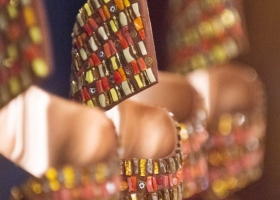
The Best ofIntima & Swim Edit
Gold Reflections in the southern French Alps
19 March 2024
La Maison des Grenadières houses a workshop and museum showcasing an age-old skill: that of embroidery using gold thread.

Nestled in the small village of Cervières in France's entrancing Forez mountain region, La Maison des Grenadières houses a workshop and museum showcasing an age-old skill: that of embroidery using gold thread, mastered over the centuries by the so-called "Grenadières". We invite you to delve into France’s heritage and discover this sophisticated tradition.
The technique of gold embroidery was originally used by the
kings of France in the Middle Ages, after the
Crusaders had brought this craft form with them upon returning from Asia.
Practised exclusively by men, the skill came back into fashion under Napoleon,
when it was used to decorate the uniforms of an elite military corps known as
the Grenadiers, who took their name from the pomegranate symbol adorning their
uniforms. The art form reached its pinnacle at the end of the 19th century in
the Vêtre valley. Here it was made
popular under the virtuoso hands of peasant embroiderers known as
"Grenadières", who worked from home to adorn military, high-dignitary
or even liturgical garments. Between the wars and up until 1950, under the
leadership of two sisters in Saint-Julien Lavette, gold-thread embroidery enjoyed
a golden age, when orders poured in from all over the world, with quantities
reaching into the thousands for corps such as the Navy.

With time the Grenadières realized the importance of preserving this unique know how taking on a heritage role, and to this end in 2002 they opened the doors of the Maison des Grenadières workshop and museum. Here we find a showcase of their work, tracing the craft’s history which is brought alive by presentations on special occasions, such as Heritage Day. The museum includes stylish vintage items including coats of arms and badges from Chanel, Hermès and Givenchy maisons, while also hosting temporary exhibitions, for example the very successful one on the topic of corsets. Visitors can discover different embroidery techniques: the cannetille, using copper thread electrolysed in a bath of silver or gold distinguished by its spiral twist; the filé, an embroidery technique which is identical front and back; or the jaseron, used for ceremonial outfits, where the hollow wire is wound around a needle to make a very tight spiral with intense metallic reflections.
Historically, and to this day, the threads are sourced from Carlhian, specialising in the manufacture of gilding and trimmings in the Lyon region. In addition to illustrious commissions such as those for the Freemasons, academic robes embroidered with silk thread, or for government officials’ uniforms, the museum continues to bring its heritage to life by collaborating with the Art Knives of Thiers and illustrious young companies such as The Comptoir, who recently ordered supplies of embroidery kits from them.

These days, however, expertise has become short in supply and the number of Grenadières can be counted on the fingers of one hand. One of these is Azélina Michelet, who regularly gives demonstrations at the museum. She has always felt this was her true calling. As a child, she was attracted to manual work and already at age six her grandmother introduced her to embroidery. It was love at first sight, and the decision was made: "Even if it seemed like an old-fashioned craft at the time, I knew I was going to be an embroiderer!”
Azélina enrolled at Rochefort’s Lycée Professionnel Gilles Jamain, one of the few schools in France to train embroiderers. Subsequently she earned a Brevet des Métiers d'Art specialising in gold-thread embroidery, going on to obtain a diploma in costume making which enabled her to refine her technique. To further expand her craft, Azélina moved to Madrid, where she worked decorating bullfighters' robes with gold thread. "They use a different technique there, because the know-how in Spain is linked to the country’s culture. Soaking up the Spanish heritage and attending workshops complemented my studies in France". Upon returning to Paris, she worked for the Moulin Rouge and the Cécile Henri and Paloma ateliers, part of the Chanel Métiers d'Art. Here she had the opportunity to embroider luxury and haute-couture pieces for the likes of Givenchy, Chanel, Dior, Balenciaga and Louis Vuitton. Fuelled by her unrelenting passion Azélina went on to transpose embroidery samples onto dream dresses for Maison Lesage. Azélina admits she is fascinated by the precious metal: "Initially it comes across as a cold material, but it brings light, emotion and intense warmth once it's embroidered on a garment".

The museum-workshops offer two-hour introductory courses in gold embroidery every third Saturday of the month from April to November, and every Saturday morning in July and August. As well as an introduction to the technique, trainees leave with all the materials necessary to continue learning at home. For more experienced textile professionals, the museum offers training courses in partnership with the Association des Grenadières, created in 2012, which works to safeguard this unique technique and promote the luxury crafts of the Loire.
La Maison des Grenadières offers other sewing-related workshops. One of these is the "Culottes Workshop", with the aim of teaching participants how to make "responsible panties". Throughout courses specialists give participants the opportunity to make a delicate piece of clothing using recycled or second-hand lingerie fabrics. The students, who must already have a basic sewing technique, learn how to assemble jerseys, work lace, fit elastics and will leave with a perfectly fitting pair of panties. In the museum's small workshop, Azélina tirelessly carries on the ancestral gestures of the Grenadières: she mounts the buttercloth on the loom, then glues it with a mixture of flour and water. On top of this she lays her felt or woollen sheet, which she will craft with a pattern drawn on tracing paper that she has stitched and polished. This delicate stage involves making holes in the paper, then sprinkling it with a powdery ink that will transfer onto the fabric. Next, Azélina applies a cardboard cut-out to give the design relief before starting to embroider it. Finally, the embroiderer takes the precious shiny, matt or curly spiral, reinforced with a thread coated with beeswax to make it smooth and resistant to metal wear; she winds it onto her needle and proceeds to decorate the fabric. "The fingering is meticulous, demanding, fascinating and requires extreme regularity in the stitch, as I work to the nearest millimetre. It's a moving gesture that allows you to express yourself and unleash your creativity by combining it with these skills," says Azélina.

Despite her ability, Azélina continues to work on her art, because as she says, "it's an extremely rare and ancient skill that requires a high level of dexterity which can only be acquired through regular practice to achieve the perfection I'm looking for". For Azélina, gold thread embroidery is her whole life, and it's also "a living material that transforms, evolves and reacts to the humidity and heat. As it oxidises, the tarnish changes the objects and clothes; it gives them an incredible allure, and a different guise which I find moving, whatever the result over time". The embroiderer has not as yet had the opportunity to work on lingerie or wedding dresses, and admits that it would be a compelling experience to bring together the preciousness of gold thread with that of fine materials such as lace
Copyright 2025. All right reserved - Terms








